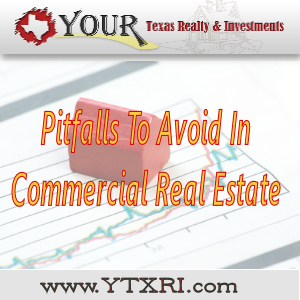 In order to be successful in Texas commercial real estate, it is a good idea to avoid as many pitfalls as possible. Learn about these common mistakes so you don’t make them as well!
In order to be successful in Texas commercial real estate, it is a good idea to avoid as many pitfalls as possible. Learn about these common mistakes so you don’t make them as well!
As wonderful and constant as Texas commercial real estate is, there are some major pitfalls that can completely ruin the interest, investment and return on a property.
Besides inaccurate assessments and risks that are beyond your comfort zone, the only real reason these pitfalls occur is because of the lack of due diligence that you perform. By not investigating deeply enough, not overturning every rock, and rushing into what seems like an awesome deal, you can experience some horrible events that can literally cost you hundreds and thousands of dollars.
These are setbacks I hope you never experience by asking every question, verifying everything, and assuming nothing.
Below you will find some unfortunate and common mistakes that can occur if you are not completely on your game.
Some of the major pitfalls in commercial real estate are related to the zoning and use of a property. Brokers may offer information that is not accurate about the rezoning and use capabilities of a property. Although many of the people in this business are honest and have integrity, you can bet you will run across a few brokers or agents that will do and say almost anything to sell a property.
With every property you must ask yourself, “What is the worse that can happen?”
Some problems that arise may include not checking with the city planning and zoning decision makers to see if a property can and will be able to be rezoned to the zoning that is expected. Also, just because the zoning may include your use, you must check with the city to make sure there are no special contingencies regarding use.
The last thing you want is to have a property you believe can be re-zoned to a higher and more profitable use, and after you purchase it, realize you cannot do what you intended! This can mean a less of a return on investment, or a complete loss of an investment. Believe me, situations can get very bad regarding the rezoning and use of a property, and fighting with the city will take more money, energy and time than it is often worth.
Another pitfall that can arise is purchasing a building that is leased, and then losing tenants due to leases or rental agreements being up! It is important to see and verify the leases of a building to make sure you will have some income to cover the debt service while you change, renovate, or do whatever it is you are going to do with the property. Verify you will have tenants when you purchase the property; otherwise, you may not have enough income, and this can leave you in the red.
It must be acknowledged that every property and situation can differ greatly from another. Because of this, there can be many different ways that a property can go. For this reason, all “what ifs” must be addressed, as well as exit strategies created for every scenario. When you limit yourself on exit strategies, you increase your possibility for failure.
With every property you must ask yourself, “What is the worse that can happen?” Weigh the risks and the probability of the worst happening, and either plan an exit strategy for this possibility, or don’t move forward. You must look at everything from the worst to best case scenario, and have an exit strategy for each. Not only will you be prepared for anything that comes your way, but you will have less of a chance of really getting buried and losing money on an investment gone badly.
In commercial real estate, I often see a person trying to save a few thousand dollars that ends up costing him or her hundreds of thousands, just because they try to play hard ball with negotiations. It is always important to know what you are willing, and not willing to do when you go into negotiations regarding the purchase or selling of a property, as well as leasing and rental agreements.
For example, asking for $35.00 per square foot and being offered $30.00 per square foot, (reasonable in this situation), and assuming the interested party is very motivated about the space, and coming back with $33.00 a square foot and nothing less, my cause the loss of the three year leasing agreement, and the income for another two months from the property because it is not leased out is definitely not worth it!
Take the $30.00 per square foot; get the property leased up, and make an agreement that the rate will increase two or three dollars every year after. Don’t lose the tenant because you want to play hard ball in negotiations when, really, you can make it work!
As you become more educated and get closer to reaching your goal of being a real estate insider, you may want to branch out into new markets and expand your comfort zone. This is great. However, you must realize there are many differences between various types of properties. Doing a deal with a 120 unit apartment complex is different than a 55,000 square foot office building.
When moving into different markets, items can easily be overlooked, and major problems can arise, simply because you are not aware of them. It is often a good idea to partner with someone already in that new market so that you may have the benefit of experience and know-how on your side.
Learn form this venture so you will be more familiar with the market, property, and how it should be addressed. It is easy to get in over your head with new markets that can lead to major and expensive problems.
As you continue on your adventure in commercial real estate, be sure to do all your homework regarding a property. You will be less likely to run into problems, or better yet, be prepared to fix the problems if financially worth it. Never assume everything is as it appears, because, more often than not, it isn’t! You must play smart in this game, or you can lose everything.
Use you resources to get the best and most accurate information and you can avoid these pitfalls in commercial real estate.


